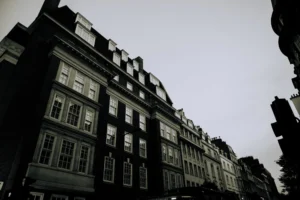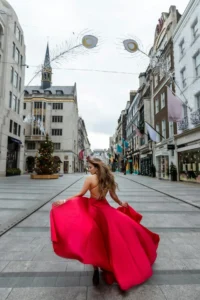Mayfair London History: A Historical Overview
Mayfair London history reveals why it stands as one of the city’s most prestigious and sought-after districts today. Its charm lies not only in its luxury but also in its rich past. This central London area has seen centuries of transformation, from open fields to an elite neighbourhood. Today, we’ll explore Mayfair’s fascinating history and the neighbouring areas that shaped it.
Early Days: From Marshland to Manor
 For example, Mayfair began as open countryside. By the 17th century, it was largely marshland. For instance, the name “Mayfair” comes from a fair held in the area each May. This event, in turn, drew crowds from across London. All in all, it ran annually from 1686 to 1764 and gave the district its lasting name.
For example, Mayfair began as open countryside. By the 17th century, it was largely marshland. For instance, the name “Mayfair” comes from a fair held in the area each May. This event, in turn, drew crowds from across London. All in all, it ran annually from 1686 to 1764 and gave the district its lasting name.
By the early 18th century, the area started to change. At that time, the Grosvenor family, one of Britain’s wealthiest, began developing the land. They built grand squares and elegant streets. As a result, Grosvenor Square quickly became the heart of fashionable London.
The Rise of a Wealthy Neighbourhood
As the 18th century progressed, Mayfair attracted the upper class. Indeed, nobles, politicians, and businessmen all made homes here. Consequently, Georgian townhouses lined the streets. Additionally, fine gardens added greenery and calm. Ultimately, the district grew into a symbol of prestige and wealth.
At the same time, nearby areas like St James’s and Marylebone also developed. St James’s became known for gentlemen’s clubs and royal connections. Marylebone offered quieter charm with elegant homes and leafy avenues.
A Centre of High Society: Mayfair London History
Mayfair truly blossomed during the Regency and Victorian eras. High society gathered at grand venues like Claridge’s and the Dorchester. Tailors on Savile Row dressed London’s elite. The area became the place to be seen.
Many famous figures lived here. For example, Florence Nightingale resided on South Street. In addition, composer George Frideric Handel lived close by in Brook Street. Consequently, these homes now stand as museums, honouring their legacies.
20th Century Challenges and Changes
The 20th century brought change. During this time, both World Wars impacted Mayfair. As a result, bombings damaged buildings. Consequently, some families left, and embassies or businesses moved in.
However, the area never lost its charm. Developers restored historic buildings. New luxury hotels, art galleries, and boutiques opened. Savile Row kept its tailoring tradition alive. Bond Street remained a top spot for fashion and jewellery.
Meanwhile, neighbouring Soho became known for nightlife and the arts. Fitzrovia attracted writers and artists. These contrasts enriched the West End as a whole.
Modern Day Mayfair
Today, Mayfair remains one of the most exclusive addresses in London. It blends history with modern style. Historic squares like Berkeley Square and Grosvenor Square still offer green spaces. Michelin-starred restaurants serve global cuisine. High-end shops continue to attract elite shoppers.
Despite its growth, Mayfair keeps its historic feel. Conservation laws protect its architecture. Restoration efforts preserve its past while embracing the present.
Notable Streets and Landmarks: Mayfair London History
 Many streets in Mayfair tell stories of the past.
Many streets in Mayfair tell stories of the past.
Savile Row
Known for bespoke tailoring, Savile Row has dressed leaders, stars, and royalty since the 19th century.
Bond Street
This shopping street dates back to the early 1700s. Meanwhile, today it’s home to luxury brands and historic jewellers.
Grosvenor Square
This square has long been a political and diplomatic hub. It once hosted the US Embassy and still features a statue of President Roosevelt.
Mount Street
Now full of designer boutiques and cafes, Mount Street retains its 18th-century charm.
Mayfair’s Surroundings and Their Roles
While Mayfair shone, nearby areas added depth to the region.
St James’s
With royal parks and historic clubs, St James’s became a political and cultural centre.
Marylebone
Once a village, Marylebone grew into a refined district. The famous Harley Street attracted doctors and specialists. Baker Street, meanwhile, became linked to Sherlock Holmes.
Soho
In contrast, Soho offered a different vibe. Known for theatres and nightlife, it played a vital role in London’s music and creative scenes.
Fitzrovia
This area blended residential calm with artistic flair. Writers like Virginia Woolf and George Orwell lived here.
Historical Figures Linked to Mayfair
 Many important people shaped Mayfair’s past.
Many important people shaped Mayfair’s past.
- Florence Nightingale: The pioneer of modern nursing lived in South Street.
- George Frideric Handel: The composer spent much of his life in Brook Street.
- Winston Churchill: Britain’s wartime Prime Minister had connections to the area.
- Beau Brummell: This style icon influenced Regency fashion from his home near Piccadilly.
A Legacy That Lives On: Mayfair London History
Moreover, Mayfair’s history continues to shape its future. Therefore, its blend of heritage and progress keeps it unique. For example, from Georgian homes to modern galleries, the area balances elegance and energy.
Neighbouring districts play their part too. Each brings its own flair, making central London a rich patchwork of culture and history.
Final Thoughts
In conclusion, Mayfair’s journey from muddy fields to a global symbol of elegance is remarkable. Over the centuries, it has evolved yet stayed true to its roots. Its buildings, people, and traditions continue to tell stories. Whether you walk through Grosvenor Square or browse Bond Street, history is always close by.
For anyone exploring London, Mayfair and its surroundings offer a beautiful blend of the past and present. Furthermore, they stand as a proud reminder of the city’s vibrant and enduring spirit.